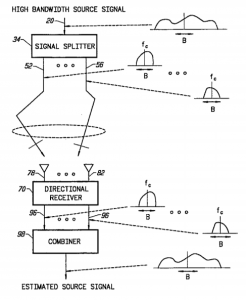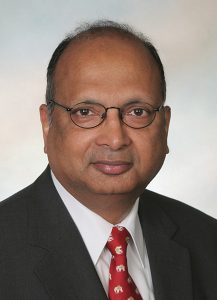A very large number of consumer devices offering wireless connectivity which are in use today utilize an antenna technology known as multiple-input and multiple-output (MIMO). MIMO is capable of multiplying radio transmissions using multiple transmit and receive antennas and is typically incorporated into devices which communicate wirelessly on Wi-Fi, 3G, 4G and 4G LTE networks. Although MIMO can be achieved with the use of a few transmit and receive antennas on a device, massive MIMO utilizing arrays of up to 128 antennas are currently being developed for the coming 5G networking revolution. Between 2018 and 2026, the global massive MIMO market is expected to grow from $1.29 billion up to $20.91 billion, according to Research and Markets.
This Thursday, September 6th, marks the 24th anniversary of the issue of a seminal patent in the field of MIMO wireless communications. Its inventor, Dr. Arogyaswami Paulraj, is a member of the 2018 class of inductees into the National Inventors Hall of Fame. Today, we return to our Evolution of Technology series to explore the story of how this inventor took advantage of his own academic skills to come to the United States and pioneer this major advance in wireless communications.
A Short History of Wireless Communications, From Hertz to Telstar
Scientific research involving the use of electromagnetic wave properties to conduct wireless transmissions extends back to the 19th century. In the late 1880s, the German physicist Heinrich Hertz conducted experiments to test the theory of electromagnetism which had been advanced two decades earlier by Scottish scientist James Clerk Maxwell. Hertz created a receiver with a gap where sparks would form when electromagnetic waves were detected, confirming Maxwell’s work and marking the first observation of what came to be known as radio waves.
Wireless transmissions took further steps forward in the 1890s thanks to a pair of renowned inventors. Italian inventor Guglielmo Marconi expanded upon the work of Hertz by creating a system for wireless telegraphy which utilized radio waves and enabled the wireless transmission of those waves over much longer distances than previously conceived. During this same decade, Serbian-American inventor Nikola Tesla developed a system of wireless power transmissions using inductive coils capable of delivering electricity to power light bulbs over distances.
The 20th century saw many important advances in wireless transmissions for various technologies. In the year 1900, the first successful transmission of audible speech using radio waves was conducted by Canadian-American inventor Reginald Fessenden, who used a high-frequency spark transmitter to transmit speech over a distance of one mile. In the early 1930s, American electrical engineer Edwin Armstrong developed a method for the frequency modulation of radio waves, creating the FM band of radio which enabled radio wave transmissions to be sent with less signal noise. A few decades later, wireless transmissions of telephone calls and television broadcasts via satellite were enabled by the launch of the first two Telstar satellites in the early 1960s.
Paulraj Invents the MIMO Wireless Transmission Method for Next-Generation Wireless Communication Devices
Arogyaswami Paulraj was born in April 1944 in the Indian town of Pollachi near the city of Coimbatore, one of six children in his family. By the age of 15, Paulraj had finished his high school education and joined the Indian Navy. He would serve in the military for 26 years, working on electrical engineering projects which involved the maintenance of the Navy’s weapons systems. By 1969, his electrical engineering work led Paulraj’s superiors in the Navy to send him to the Indian Institute of Technology at Delhi where he would end up attending lectures delivered by Thomas Kailath, a systems theorist who visited the Delhi institution from Stanford University.
Through the 1970s and early ‘80s, Paulraj completed work on sonar technologies that improved the Indian Navy’s systems, which had largely been based on British technologies. Paulraj created an improved trans-receiver-display which came into wide use across the Indian naval fleet. By 1983, Paulraj would also develop a sonar technology known as APSOH which led India to become a global leader in sonar technologies at that time. Before leaving India for the United States, Paulraj would help to establish a trio of national research laboratories focusing on scientific subjects such as artificial intelligence, computing and military electronics.
In 1991, Paulraj came to the U.S. where he joined the faculty of Stanford and began focusing his attention on experiments in wireless transmissions. His experiments began uncovering ways that wireless signals could be separated for transmission, a discovery which helped to pave the way for his eventual development of the MIMO wireless transmission method. The use of parallel data streams, transmitted through a multipath method accomplished with the use of multiple antennas in an array incorporated into a device, boosted the rate at which data could be transmitted and enabled high-speed wireless services.
 Paulraj’s revolutionary innovation is best evidenced in the issue of U.S. Patent No. 5345599, titled Increasing Capacity in Wireless Broadcast Systems Using Distributed Transmission/Direction Reception (DTDR). Issued on September 6th, 1994, this is the patent for which Paulraj has been inducted into the National Inventors Hall of Fame. It claimed a wireless broadcast system for transmission of a source signal from a plurality of spatially separated transmitters on a common frequency channel on a common frequency channel to a receiver located in a service area, the system also comprising demultiplexing means for splitting a source signal into a plurality of transmitted signals. The resulting invention increased broadcast information capacity several-fold over conventional technologies at the time, overcoming issues with limited bandwidth within a single broadcast channel.
Paulraj’s revolutionary innovation is best evidenced in the issue of U.S. Patent No. 5345599, titled Increasing Capacity in Wireless Broadcast Systems Using Distributed Transmission/Direction Reception (DTDR). Issued on September 6th, 1994, this is the patent for which Paulraj has been inducted into the National Inventors Hall of Fame. It claimed a wireless broadcast system for transmission of a source signal from a plurality of spatially separated transmitters on a common frequency channel on a common frequency channel to a receiver located in a service area, the system also comprising demultiplexing means for splitting a source signal into a plurality of transmitted signals. The resulting invention increased broadcast information capacity several-fold over conventional technologies at the time, overcoming issues with limited bandwidth within a single broadcast channel.
Paulraj’s academic work in developing MIMO led him to establish a pair of companies to commercialize his innovations. In 1998, he founded Iospan Wireless to develop MIMO cellular technologies that supported both WiMAX and LTE mobile communications networks; in 2004, Iospan was acquired by Intel Corporation. Paulraj also founded Beceem Communications, a developer of WiMAX semiconductors, a company which was acquired in 2010 by Broadcom Corporation. Paulraj continues to serve as professor emeritus at Stanford and is named as an inventor on 79 U.S. patents. Aside from his recent Hall of Fame induction, Paulraj has also been recognized for his contributions with the IEEE Alexander Graham Bell Medal (2011) and the Marconi Prize (2014).

![[IPWatchdog Logo]](https://ipwatchdog.com/wp-content/themes/IPWatchdog%20-%202023/assets/images/temp/logo-small@2x.png)


![[Advertisement]](https://ipwatchdog.com/wp-content/uploads/2024/04/Patent-Litigation-Masters-2024-sidebar-early-bird-ends-Apr-21-last-chance-700x500-1.jpg)

![[Advertisement]](https://ipwatchdog.com/wp-content/uploads/2021/12/WEBINAR-336-x-280-px.png)
![[Advertisement]](https://ipwatchdog.com/wp-content/uploads/2021/12/2021-Patent-Practice-on-Demand-recorded-Feb-2021-336-x-280.jpg)
![[Advertisement]](https://ipwatchdog.com/wp-content/uploads/2021/12/Ad-4-The-Invent-Patent-System™.png)







Join the Discussion
One comment so far.
S. Sengupta
September 7, 2018 08:51 amGood article. However, the history section does not mention the pioneering contributions of Sir J.C. Bose and his experiments in millimeter waves, and that of Alexander Popov – contemporaries of Marconi and Hertz.